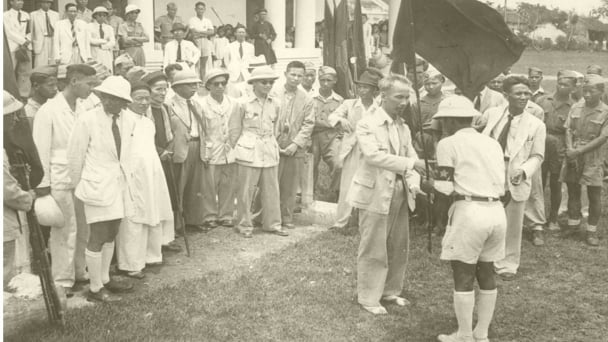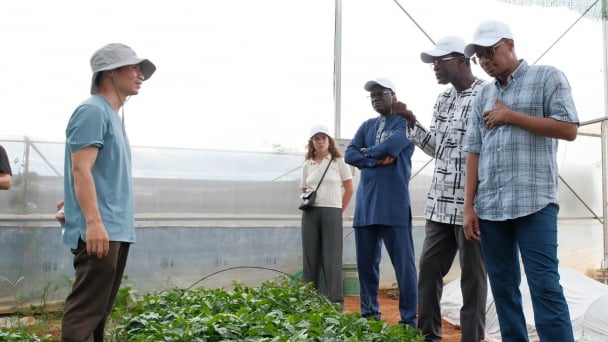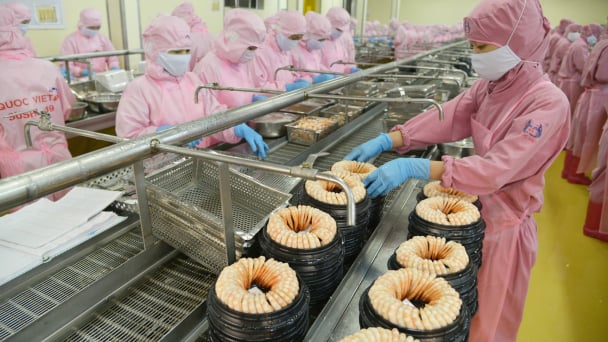September 7, 2025 | 07:37 GMT +7
September 7, 2025 | 07:37 GMT +7
Hotline: 0913.378.918
September 7, 2025 | 07:37 GMT +7
Hotline: 0913.378.918
This lasting honor, born of profound respect, is how generations of officials commemorate the founding Director-General of the General Department of Hydrometeorology - the forerunner to today’s Hydrometeorological Administration under the Ministry of Agriculture and Environment.
Across the 80-year history of this critical sector, former Director-General Tran Van An (1925-2010) stands as a monumental figure. He dedicated nearly three decades of his life to the field, proving instrumental in forging the foundations of a scientific discipline committed to serving the Vietnamese people and nation.

Director-General Tran Van An (second from left) monitors a storm alongside forecasters from the Forecasting Department of the General Department of Hydrometeorology. Photo: Courtesy of Tran Van An's family.
Upon securing independence in 1945, the fledgling Democratic Republic of Vietnam faced staggering challenges: a devastated economy, ongoing conflict, and a near-complete absence of scientific and technical capacity. The existing hydrometeorological system, a tool of French colonial exploitation, was left in ruins, a handful of scattered stations with derelict equipment and skeletal staffing.
Despite this, the nation's new leaders had the foresight to grasp an essential truth: national development, defense, and public welfare were contingent upon understanding the forces of nature, particularly weather, climate, and hydrology. A pivotal first step was taken on October 3, 1945, when Presidential Decree No. 41 brought the Department of Astronomy and the Phu Lien Astronomical Observatory under state control. That date is now honored as the sector's anniversary. True autonomy arrived on September 28, 1955, with Government Decree No. 588/TTg, which established the Meteorological Department as an independent agency under the Prime Minister's Office.
Tran Van An’s journey into meteorology began in 1964, a turning point during the nation’s arduous resistance against the United States. The government appointed him Deputy Director of the Meteorological Department, a stark career shift for a seasoned revolutionary. His early life was defined by leadership; at just 22, he was Party Secretary of Nghia Hanh District in Quang Ngai province, and by 24, he led the entire province. His diverse career path later spanned roles as Party Secretary of Binh Dinh province, Party Secretary for the Ministry of Health, Director of the Hanoi Department of Health, and Vice-Rector of Hanoi Medical University.

Director-General Tran Van An, leading a delegation from the General Department of Hydrometeorology, meets with the head of the Nam Dong Meteorological Station (Thua Thien - Hue) in the A Sau Valley on August 29, 1974. Photo: Courtesy of Tran Van An's family.
His defining trait was an insatiable drive for knowledge. When assigned to health, he pursued medical studies. Tasked with meteorology, he immersed himself in atmospheric physics and mathematics, ultimately earning an honors degree. His fluency in four languages - French, English, Russian, and Chinese, provided direct access to global scientific knowledge and established him as a powerful example of lifelong learning and passionate professional dedication.
Amidst the hardships of war, Tran Van An and his colleagues not only sustained but expanded the network of rain and water-level stations. This data served both agricultural production and national defense, transforming weather intelligence into a strategic asset. Information on typhoon tracks and river conditions became critical for military and civilian planning, directly aiding the resistance effort.

The hydrometeorological delegation from the Democratic Republic of Vietnam and the Republic of South Vietnam at the Seventh World Meteorological Congress in 1975. Photo: Courtesy of Tran Van An's family.
Following reunification, the mandate for national reconstruction presented new challenges. In 1976, Tran Van An was appointed to lead the newly formed General Department of Hydrometeorology, created by merging the Department of Meteorology and the Hydrology Bureau.
His first priority was to consolidate and expand the fractured national monitoring network, which he identified as the sector's backbone. He spearheaded a "people's network" initiative, establishing hundreds of manual observation points across plains, mountains, and islands. This effort, combining grassroots data collection with early technology, dramatically increased the density of available information.

Deputy Prime Minister Vo Nguyen Giap and Director-General Tran Van An welcome the Secretary-General of the World Meteorological Organization (WMO) during his visit to Vietnam. Photo courtesy of the family.
Under his leadership, the system grew from a few dozen stations left by the French and the former Saigon administration to 500 nationwide by 1990. He oversaw the introduction of then-advanced technologies like radio transceivers and facsimile machines, which systematized forecasting and data dissemination. A specialized information system was established with three core clusters: coastal and island stations for storm warnings, headwater stations for flood forecasting, and a cluster for international data exchange via links with Moscow, Beijing, and Bangkok.
Tran Van An’s vision extended far beyond infrastructure. A fierce advocate for human capital, he constantly pushed his staff to pursue research and higher education. He encouraged generations of experts to study abroad, who then returned to form the sector's professional core. He successfully drew top talent from mathematics, physics, and other sciences into the field, building a formidable team of forecasters.

Director-General Tran Van An welcoming Mr. G.O.P. Obasi, Secretary-General of the World Meteorological Organization (WMO), during his official visit to work with Vietnam's hydrometeorology sector in 1990. Photo: Courtesy of Tran Van An's family.
His decades of service earned him two terms as a National Assembly delegate and numerous state honors, including the Second-Class Independence Medal, the First-Class Medals for the resistance wars against France and the U.S., and the 60-Year Party Membership Badge. In every capacity, he remained a model of selfless contribution.
In 2025, on the centennial of his birth, his home province of Quang Ngai held a major ceremony to honor his legacy. A century on, Tran Van An is remembered with reverence as the man who sowed the seeds and laid the enduring foundation for a scientific field devoted to the nation. It is this foundation that allows Vietnam’s hydrometeorology sector to confidently navigate the climate challenges of today.
Translated by Linh Linh
/2025/09/03/4944-3-184250_214.jpg)
(VAN) Land statistics and inventory have always played a crucial role as an effective management tool, enabling the State to firmly grasp, rationally allocate, and efficiently utilize this immense resource.

(VAN) The Prime Minister calls for stronger traceability and quality assurance of export farm and fishery products, and a faster customs process for businesses.

(VAN) Marking the 80th anniversary of the agriculture and environment sector, historian Duong Trung Quoc recalls the nation’s earliest efforts to build and protect dykes in the days immediately after independence.
/2025/09/01/1540-3-180406_278.jpg)
(VAN) Consolidating land fund development organizations aims to ensure transparent management, secure proactive resources, and support socio-economic development.

(VAN) Through South-South cooperation, Vietnam is steadily asserting its role as a global food security creator, contributing to a more sustainable and equitable world.

(VAN) In the wave of integration, only sectors that adapt can thrive. Vietnam’s seafood industry is choosing diversification to reach new heights.